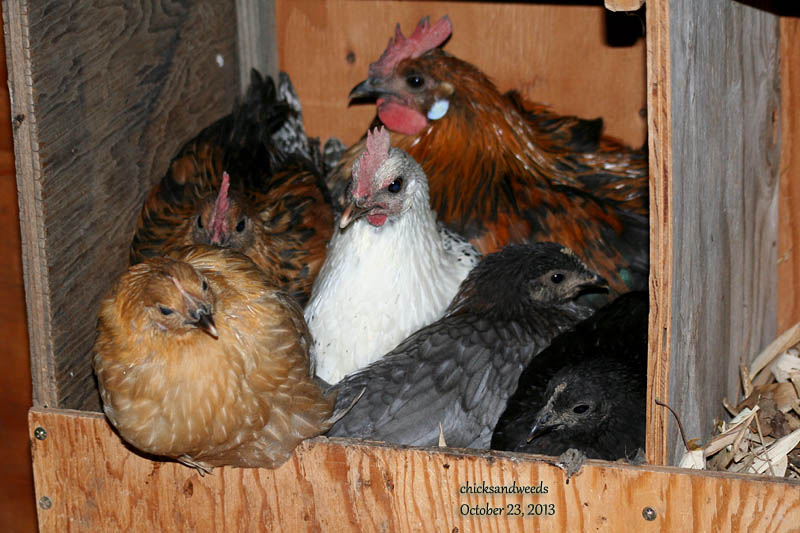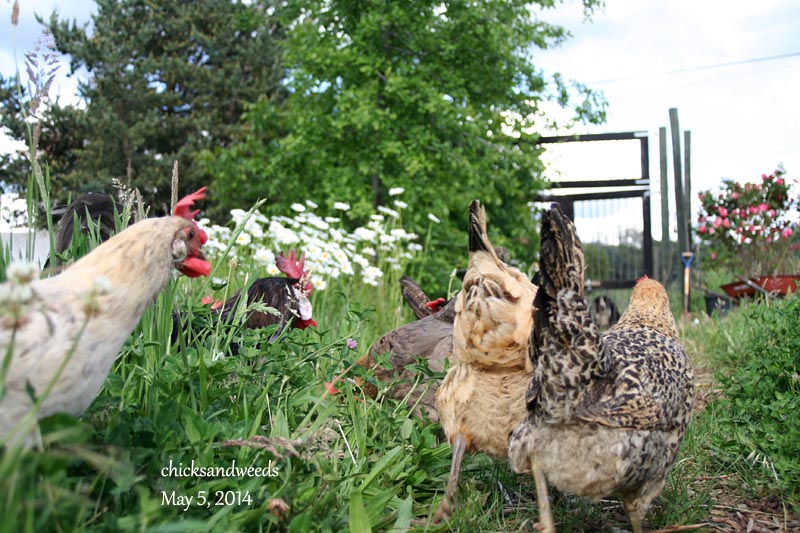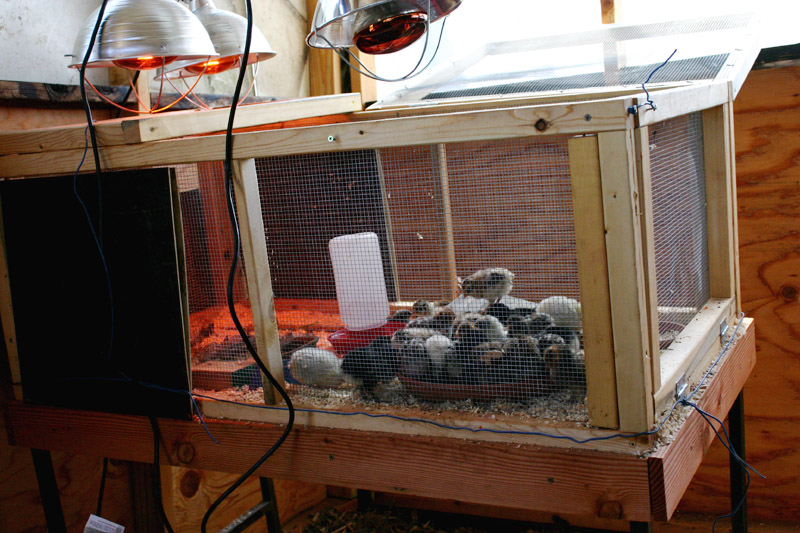
You mentioned you wanted some chickens. I think that is great – you’ll love them – and even though it might look like that there is a lot to consider, it is pretty easy – and fun. But then, I love chickens – all birds – and doing something you love makes everything easier.
A little clarity and intention put in ahead of time will really pay off later.
You’ll need a safe coop, and outside run, feed and chickens – I admire those cute coops for the suburban chicken keeper – who have something like 3-5 chickens …, but that just wasn’t gonna work for the number of chickens I was planning on…so we have a very rustic coop make with 1x2x, 2x2x, 4 posts, plywood and hardware-cloth.
I believe in providing chickens an as natural environment as possible. To keep them healthy and resilient, providing good nutrition and enough space are crucial – as are genetics and gentle up-bringing. Flapping your arms or wearing wavy clothes or walking fast – will set of their flight response – and if you ‘d like those amazing interactions – walk like in chicken tai-chi and don’t wear red colored shirts when you got them used to seeing you in black and green. If you are good at building things – that can come in real handy when keeping more than just 2 or 3 hens ….:)
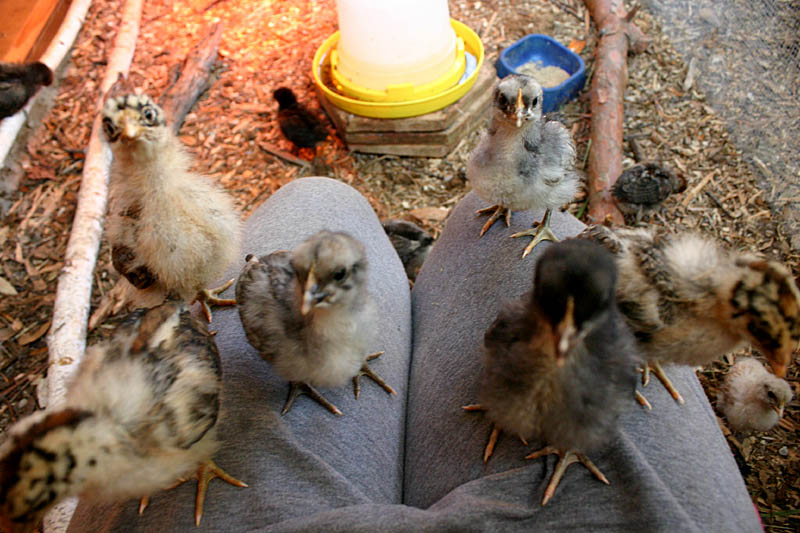
I got my chicks (25 in May and another 25 in September) from a preservation hatchery and they were non sexed, meaning, they didn’t magically get rid of the males for me. My chicks are not vaccinated and I exposed them to the local dirt from the day after I got them to build up they immunity against the local coccidia. They get organic feed, first chick starter, then after 18 weeks, layer feed, kitchen scraps and free range stuff. Now that we have babies again, who can get kidney damage from eating the high calcium layer feed, they all get chick starter with the layers having access to egg shells and crushed oyster shell.
Here are some questions you may want to ask yourself before you get chickens. This only because – it just works out better later on. If you really just want 3 or 4 hens…it is real easy.
Do you care about the animal welfare side of keeping chickens?
The answer to that will play a role in where you get your chickens from and what kinds of breeds are acceptable to you. Remember, if you want egg layers, that means the breed does not have enough meat on them to make the males useful and so they usually are gotten rid of at birth. I did not want to do that, but that is the only option many folks have who live in the city where roosters are not allowed. Feed-stores have the most commonly used breeds from the commercial hatcheries.
What do you want your chickens for?
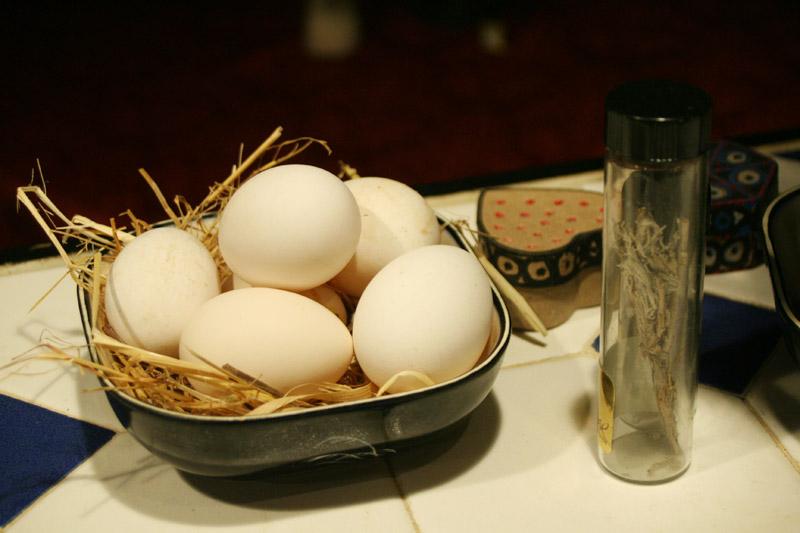
Do you want eggs? meat? eggs and meat? health? pets? Entertainment and therapy are a side effect of any chickens you share your life with 🙂 The delight they can bring is priceless. Depending on your answer as to what you want chickens for, the chicken breed you want is different. (Egg color was not important to me, even though it would be nice if some eggs were green or blue….)
(One word ahead of time – I will not discuss the meat chickens, which are bred to weight the equivalent of about 250 lbs in a 2 year old human. No matter what kind of a free range life you are giving them, I consider it fundamentally animal abuse and can’t help you there, so you’re on your own on that one.)If you want chickens for meat only and can deal with getting some eggs, choose a dual purpose breed. You will need to kill them and dress them – I found that I am not willing to do the killing part except should it be necessary at some point to relieve suffering …. and regret having gotten dual purpose birds (egg layers with a decent weight – but they eat more – and unless you want them for meat also, it is a waste as it does make a difference in your feed cost). If you have dogs and can stomach the killing, the roosters will make good food.
Egg laying breeds are usually considered “light” chickens. The animal welfare standard is no more than 280 eggs per laying cycle…which to me means – all year except during molting, that is almost an egg a day when they are laying. I am ok with 4-6 eggs per week from a hen, which is less – because: I have seen how they labor – and don’t want slave labor. Laying an egg IS hard on them – and they do deserve to be treated as best you can.
So, how many eggs do you want each day? – get twice as many chickens – if you have extra eggs in the spring and early summer, sell them at work or give them to friends.
Keep in mind that during molting, when they are broody or raising chicks they lay no eggs. Molting (change of feathers) happens usually in the fall after maturity, in other words, my chickens from May and September 2012 molted in fall 2013 – with very little egg production from the flock – except from the ones that got hatched in 2013. Laying also goes way down in winters, and to some degree, during heat spells.
So, if you reliably aim for say 5 eggs a day – you will need about 8-10 hens…but in the spring, there will be days and even weeks you will get 8-10 eggs a day.
Do you want a rooster?
If you are agriculturally zoned, having a rooster is fun – they protect their flock, are beautiful, mine are all non-aggressive – and – they will want to mate, and you might have baby chicks one day. Mating however can be hard on the hens if there are only 3 or 4 around because – since they lay eggs almost all year long and hence mating goes on any time they are laying, their backs can loose all the feathers from being mounted. Better to have a 1:10 ratio – and don’t get a huge rooster and small hens = hard on the girls. Do it the opposite: smallish rooster with larger hens.
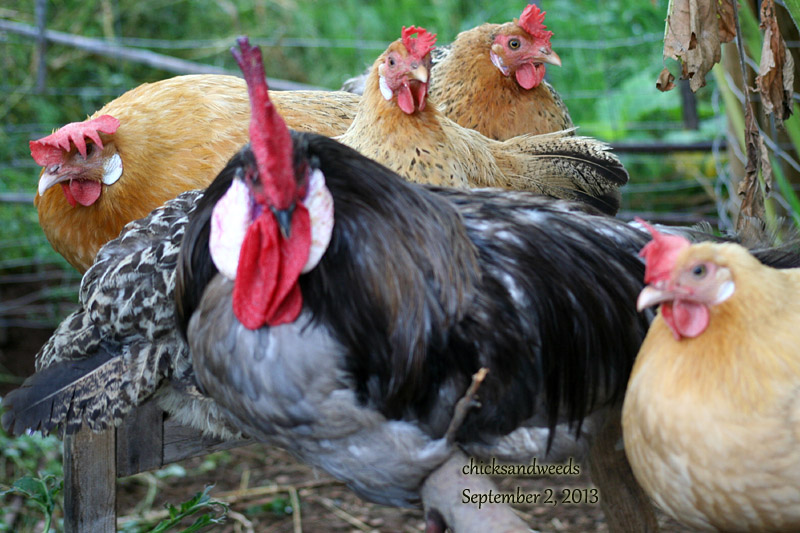 I LOVE my roosters – I had 32 the first year :)but we won’t even go into that. Rooster to rooster aggression in the breeds I have was largely a space issue, but mostly non-existent. I have 4 roosters now and – I can’t really keep any more….only because it is hard on the hens and – they eat more because they are bigger – it adds up. The only reason to keep more than 1 or 2 roosters is if you want to actually breed purebred chickens.
I LOVE my roosters – I had 32 the first year :)but we won’t even go into that. Rooster to rooster aggression in the breeds I have was largely a space issue, but mostly non-existent. I have 4 roosters now and – I can’t really keep any more….only because it is hard on the hens and – they eat more because they are bigger – it adds up. The only reason to keep more than 1 or 2 roosters is if you want to actually breed purebred chickens.
What do I do with the chicks that hatch each year that turn out to be roosters? They will go to the feed-store at some point. (I have spend hundreds of dollars re-homing some of my first flock (32 roos in all) – and that just is not an option, not that all did find a home. It helps if you have specialty purebred breeds if you want them to find a home…rather than a home with being dinner at some point.
SPACE
Ideally, you will have 4 sq feet per bird in the coop and 10 sq feet in the run, if that is all they have. My coop was made for 25 bird, now I have 33 in it – and it really would be too small if they had to stay in there all day…but they range all day unless I keep them in the run for some special reason. Part of the run has a simple roof on it (DIY with 1x2s and plastic for the rainy season).
For someone who only wants 2 or 3 birds, they have these cute little coops you can get. I needed a coop for 25 layers to start with, but ultimately about 40….so those cute coops really never were an option …
If you have racoons, weasels, rodents, foxes, dogs – and you still want to sleep well at night after getting chickens MAKE YOUR COOP PREDATOR PROOF – using 1/4 inch hardware cloth and yes, if there are spaces you can put your thumb through …a rodent can get in. A bird net covered run is also very good for peace of mind as well as the life of chickens. My birds free range during the day … and I never lost one yet – only the ones that were roosting outside at night – NOT inside the coop – several were gotten – always in the early morning, Blacky was one of them …I still miss him ….
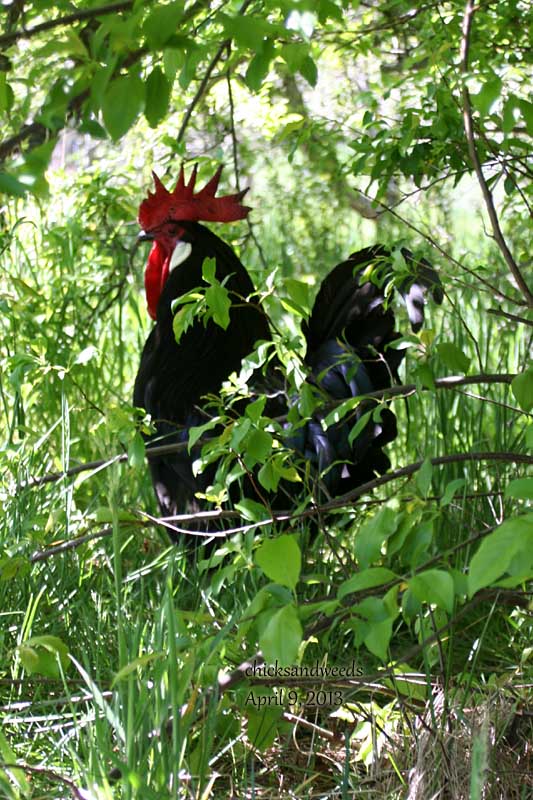
COOP FLOOR: I LOVE deep litter flooring, would use 2 rows of cement cinder blocks in ground under the walls and put the wood on that. Mine didn’t have that and I had to install a digger guard all around the coop and a foot deep – 18 inches deep would be better.
Good VENTILATION is a must if you want to not have frostbite on the combs in the winter….and also helps in the summer.
If I had to do it over, I would have a bigger coop with inside walls (framed chicken wire works) and removable doors which would allow me to subdivide into 3 parts easily, each with a pop door to the outside.
Could be you want to keep an extra rooster, breed specific hens, or give mamas and chicks a safe place.
You will need some sort of box for a hospital. A dog crate will do.
Weather considerations: For warm/hot climates I recommend to choose heat tolerant chickens. They love to hang out in deep shade during the hot part of the day, when it is best to leave them alone. The really benefit from several sources of cool water near their favorite hang out places.
Cold: unless the coop is not well ventilated, they should be ok in warmer climates like California. Ventilation is so important because if the air gets too humid (breath) and it is freezing in the coop and the humidity settles on the combs…they will freeze …dry air is ok.
For the run outside, chicken wire works well to create subdivisions or to create protected garden areas. In a panic, they will fly over it, but otherwise, they respect the fencing.
The deep litter (all the leaves and chicken poop) gets used in the garden.
Again, a little clarity and intention put in ahead of time will really pay off later.
I am planning to get more chickens next year from the hatchery, Sandhill preservation. …but then, maybe I’ll just let them hatch some more ….
Considering: Islandic chickens (very very hardy, good foragers and breed in need of conservation – I already have the coop for them) and Egyptian Fayoumis: good foragers, great mothers IF they go broody, naturally immune to Marek’s, good layers and the roosters are very very good watchers.
Why would I probably not get more buttercups for now, while I still have the bigger Buff catakanas: Because they are so so sweet …and smallish – and ALL the roosters seem to like them best …it is too hard on them unless you only have other similarly sized breeds and only 1 or 2 roosters…Like having only buttercups and Fayoumis would have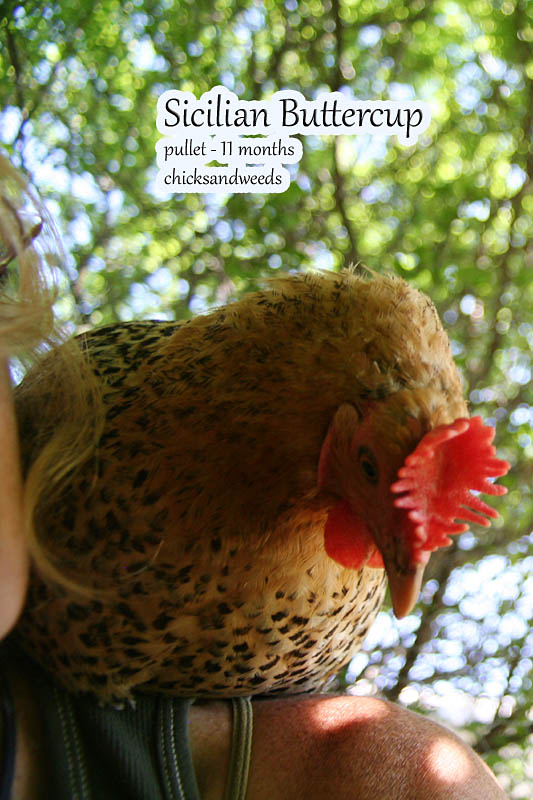 worked.
worked.
I love the blue Andalusians – they are fun – especially if the markings are good and you will let them have babies. They are a rare breed, but I like the Fayoumis better – very alert and agile but more laid back in a way. And I find I am ok with smaller chickens …:) There are only 2 Fayoumis in the flock now …and I would like to breed immunity to Marek’s into my flock, and they are immune. Ultimately I would like to create a local breed, heat tolerant egg-layers who forage well, are immune to Marek’s, generally healthy with a friendly, laid back temperament while good watchers for predators.
So anyway, that is the plan for next year …I will need to finish another coop addition before then however 🙂
The joy and relaxation chickens provide – is – priceless 🙂
